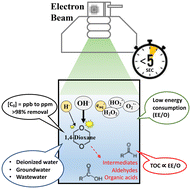Emerging investigator series: low doses of electron beam irradiation effectively degrade 1,4-dioxane in water within a few seconds†
Abstract
The application of electron beam (e-beam) technology for water treatment has been proposed to be a faster and safer approach to decomposing persistent contaminants in water, because of its ability to rapidly generate high amounts of both oxidizing and reducing reactive species without the addition of chemicals. In this study, we utilized a lab-scale 9 MeV e-beam accelerator to investigate the feasibility of treating 1,4-dioxane in various water matrices in batches with low sample volumes (<90 mL). Very low doses (<5 kGy) and treatment times (<5 s) were sufficient to degrade >98% of 1,4-dioxane within the range of environmentally relevant concentrations (0.1–10 mg L−1), without the need for any sample modification or pH adjustment. Low dissolved oxygen in the solution enhanced the degradation efficiency by 21–23% when treating 1000 mg L−1 of 1,4-dioxane, presumably because of the increased H˙ and O˙− that can react with 1,4-dioxane. Although the degrading intermediates were not fully mineralized to carbon dioxide at the tested doses, the detected intermediates, such as aldehydes and organic acids, were not as persistent as 1,4-dioxane and were more vulnerable to conventional treatment methods and natural attenuation. The slowest reaction rate constant was observed when treating wastewater samples (k = 0.13–0.62 kGy−1), followed by contaminated groundwater (k = 0.16–1.4 kGy−1), suggesting other organics and ions could scavenge the generated reactive species. The electrical energy per order (EE/O) ranged from 0.39 (DI water) to 6.3 (wastewater) kWh m−3 per order, depending on the initial concentration of 1,4-dioxane and water matrix. The EE/O values were comparable to other traditional advanced oxidation processes (AOPs) to treat 1,4-dioxane, suggesting the feasibility of utilizing e-beam to treat contaminated waters. The organic carbon content of the sample positively correlated (R2 >0.9) with the EE/O values and thus can be utilized to predict e-beam treatment performance. Our results show that e-beam radiolysis is a promising technology to treat 1,4-dioxane and could potentially outperform other AOPs and 1,4-dioxane disposal methods (e.g., incineration) in terms of energy consumption and treatment time, leaving no trace of oxidants.

- This article is part of the themed collection: Emerging Investigator Series


 Please wait while we load your content...
Please wait while we load your content...